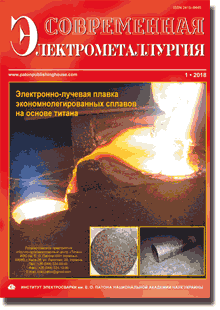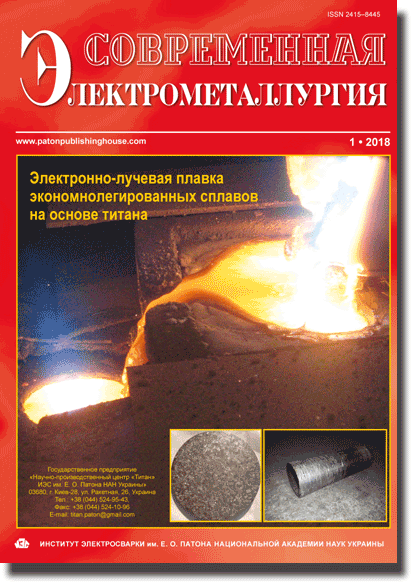| 2018 №01 (02) |
DOI of Article 10.15407/sem2018.01.03 |
2018 №01 (04) |

Electrometallurgy Today (Sovremennaya Elektrometallurgiya), 2018, #1, 17-27 pages
Mathematical modeling of process of formation of multilayer 3D structure by additive method using electric arc heat sources
V.A. Kostin, G.M. Grigorenko, V.A. Shapovalov, A.N. Pikulin
E.O. Paton Electric Welding Institute of the NAS of Ukraine.
11 Kazimir Malevich Str., 03150, Kyiv, Ukraine. E-mail: office@paton.kiev.ua
The results of simulation of temperature fields, kinetics of deposition of layers of dissimilar metals and the character of structural transformations during the formation of an additive multilayer structure of 17G1S and 30XGS steels are presented. For the computer simulation, the COMSOL Multiphysics calculation package was used. The effect of temperature on the thermophysical parameters of steels was taken into account. The simultaneous effect of three arcs on the process of formation of deposits, kinetics of structural transformations and the diffusion processes of the redistribution of alloying elements was studied. It is shown that to reduce the stress level between additive deposit and substrate up to 50 MPa it is necessary at the beginning of the deposition process to apply the preheating of substrate by arc without application of material being deposited and also to keep the time of passing between the adjacent arc heat sources in the range from 5 to 30 s. It has been established that at low arc power (1 kW), a ferrite-bainite structure is predominantly formed in the deposit, the share of bainite in which is 71 % , 28 % ferrite, and about 1 % martensite. When using an arc of higher power (5 kW), a bainite-martensite structure is formed in the deposit, the share of bainite in which is about 50 %, the share of martensite increases to 40 % and ferrite — to 10 %. The increase in arc power leads to increase in maximum temperature of the molten pool to 1750...1850 ºC, increase in the cooling rate to 15...25 ºС/s and, as a result, increase in the share of martensite in the structure of the deposited layers. A software has been developed that can be used for mathematical modeling of the metallurgical additive process of forming products from various steels and alloys. Ref. 16, Tab. 2, Fig. 8.
Key words: additive production; modeling; deposition; functional materials; structural transformations; microstructure
Received: 22.01.18
Published: 20.03.18
References
1. Zhukov, V.V., Grigorenko, G.M., Shapovalov, V.A. (2016) Additive manufacturing of metal products (Review). The Paton Welding J., 5–6, 137–142. https://doi.org/10.15407/tpwj2016.06.24
2. Akhonin, S.V., Vrzhizhevsky, E.L., Belous, V.Yu., Petrichenko, I.K. (2016) Electron beam 3D-deposition of titanium parts. , 130–133.
3. Korzhik, V.N., Khaskin, V.Yu., Grinyuk, A.A. et al. (2016) 3D-printing of metallic volumetric parts of complex shape based on welding plasma-arc technologies (Review). , 117–123.
4. Wong, K. V., Hernandez, A. (2012) A review of additive manufacturing. Intern. Scholarly Research Network. Mechanical Engineering, 2012. https://doi.org/10.5402/2012/208760
5. Dave, V. R., Matz, J. E., Eagar, T. W. (1995) Electron beam solid freeform fabrication of metal parts. Proc. of the Solid Freeform Fabrication Symp., Univ. of TX, Austin, 64–70.
6. Jandric, Z., Labudovic, M., Kovacevic, R. (2004) Effect of heat sink on microstructure of three-dimensional parts built by welding-based deposition. J. of Machine Tools and Manufacture, 44(7–8), 785–796. https://doi.org/10.1016/j.ijmachtools.2004.01.009
7. Shapovalv, V.A., Grigorenko, G.M. (2015) Metal structure control during solidification. Elektrometall., 2, 51–54 [in Russian]. https://doi.org/10.15407/sem2015.02.08
8. Shapovalov, V.A., Grigorenko, G.M. (2015) Supression of liquation processes in large ingots. , 1, 26–30 [in Russian].
9. Volyansky, I., Shishkovsky, I. (2016) Laser assisted 3D printing of functional graded structures from polymer covered nanocomposites. New Trends in 3D Printing. Ed. I.V. by Shishkovsky. Rijeka, Croatia, 237–258. https://doi.org/10.5772/63565
10. Shishkovsky, I.V. (2016) Basics of additive high resolution technologies. St.-Petersburg, Piter [in Russian].
11. Spencer, P. J. (2008) Brief history of CALPHAD. CALPHAD, 32, 1–8. https://doi.org/10.1016/j.calphad.2007.10.001
12. Kostin, V.A., Grigorenko, G.M. (2017) Peculiarities of formation of 3D structure of S460M steel product in additive metallurgical technology. Elektrometall., 3, 33–42 [in Russian]. https://doi.org/10.15407/sem2017.03.06
13. Paton, B.E. (2014) Investigations and development of E.O.Paton ElectricWelding Institute for modern power engineering. Diagnost. i Nerazrush. Kontrol, 1, 3–11 [in Russian].
14. Kostin, V.A., Grigorenko, G.M., Zhukov, V.V. (2017) Modeling of metallurgical additive process of manufacture of 09G2S steel structures. Elektrometall., 2, 35–44 [in Russian].
15. Blanter, M.E. (1962) Phase transformations in heat treatment of steels. Moscow, GNTIL on Chyorn. i Tsvet. Metallurgii [in Russian].
16. Wert, C. A. (1950) Diffusion coefficient of C in α-iron. Rev., 79(4), 601–606.
The cost of subscription/purchase order journals or individual articles
| Journal/Currency | Annual Set | 1 issue printed |
1 issue |
one article |
| TPWJ/USD | 384 $ | 32 $ | 26 $ | 13 $ |
| TPWJ/EUR | 348 € | 29 € | 24 € | 12 € |
| TPWJ/UAH | 7200 UAH | 600 UAH | 600 UAH | 280 UAH |
| AS/UAH | 1800 UAH | 300 UAH | 300 UAH | 150 UAH |
| AS/USD | 192 $ | 32 $ | 26 $ | 13 $ |
| AS/EUR | 180 € | 30 € | 25 € | 12 € |
| SEM/UAH | 1200 UAH | 300 UAH | 300 UAH | 150 UAH |
| SEM/USD | 128 $ | 32 $ | 26 $ | 13 $ |
| SEM/EUR | 120 € | 30 € | 25 € | 12 € |
| TDNK/UAH | 1200 UAH | 300 UAH | 300 UAH | 150 UAH |
| TDNK/USD | 128 $ | 32 $ | 26 $ | 13 $ |
| TDNK/EUR | 120 € | 30 € | 25 € | 15 € |
AS = «Automatic Welding» - 6 issues per year;
TPWJ = «PATON WELDING JOURNAL» - 12 issues per year;
SEM = «Electrometallurgy Today» - 4 issues per year;
TDNK = «Technical Diagnostics and Non-Destructive Testing» - 4 issues per year.





